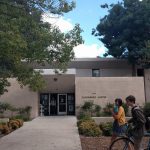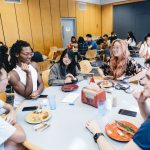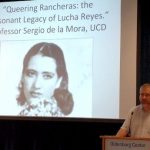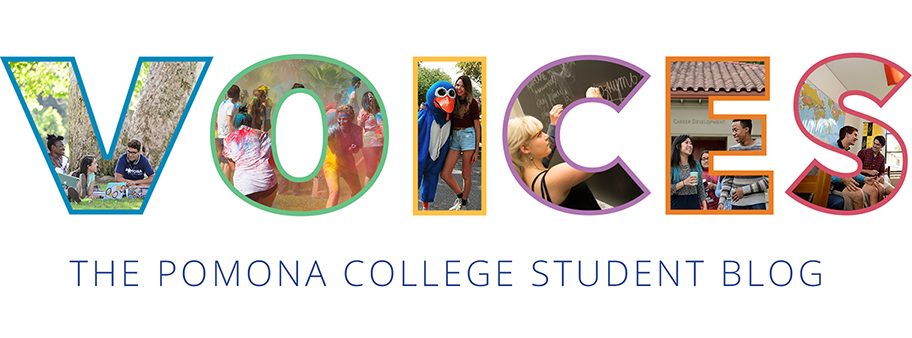By Chris Meng ’23
 The Oldenborg Center for Modern Languages and International Relations is a handful to say, so most students just refer to it as Oldenborg or Oldie for short. Built in 1966, Oldenborg is incredibly unique to Pomona, especially because we are a small college, as it is one of the only buildings that combines an international student center and language center with a dining hall, living quarters, and other cultural programming all in one place. You may have heard of other colleges’ language housing, language tables, or international centers; Pomona combines all three of those aspects in one building!
The Oldenborg Center for Modern Languages and International Relations is a handful to say, so most students just refer to it as Oldenborg or Oldie for short. Built in 1966, Oldenborg is incredibly unique to Pomona, especially because we are a small college, as it is one of the only buildings that combines an international student center and language center with a dining hall, living quarters, and other cultural programming all in one place. You may have heard of other colleges’ language housing, language tables, or international centers; Pomona combines all three of those aspects in one building!
Language Residence Halls
Every year, over 100 Pomona students live in Oldenborg’s language residence halls, where students agree to only speak the language designated to the hall while in the building. Oldenborg tends to be a popular option for sophomores, as almost every suite contains two rooms of single occupancy that share one private bathroom. I applied to live in the Chinese hall for this upcoming academic year and was accepted! Each of the six cultures and languages that Oldenborg sponsors — Chinese, French, German, Japanese, Russian, and Spanish — has their own hall with a hired Language Resident that holds conversation classes, organizes cultural events, and fosters community and conversation in their language hall and at the language tables. The Language Resident will hold study breaks and cultural activities in each of the hall’s lounges. For other languages, students can also apply to live in a multilingual hall.
Lunch at Oldenborg and Other Programming
A similar arrangement exists in the Oldenborg dining hall, which operates on weekday lunches. There are country flags at each table, marking which language must be spoken there. Almost every Pomona student will utilize Oldenborg at some point, as there is a foreign language requirement. Most language classes will require students to dine at Oldenborg about once a week.
 Even though I tested out of the language requirement, I wanted to maintain and improve my Chinese skills in order to better communicate with my extended family. So, my friend and I traversed the Oldenborg dining hall every Monday, where we quickly developed relationships with professors and students from all of the Claremont Colleges and practiced our Chinese skills. It was also one of the few dining halls that consistently offered chopsticks, which is what I use to eat meals at home. Though all seven dining halls across the colleges also offer a diverse array of food options, I appreciated how Oldenborg always served food from different cultures.
Even though I tested out of the language requirement, I wanted to maintain and improve my Chinese skills in order to better communicate with my extended family. So, my friend and I traversed the Oldenborg dining hall every Monday, where we quickly developed relationships with professors and students from all of the Claremont Colleges and practiced our Chinese skills. It was also one of the few dining halls that consistently offered chopsticks, which is what I use to eat meals at home. Though all seven dining halls across the colleges also offer a diverse array of food options, I appreciated how Oldenborg always served food from different cultures.
 Additionally, Oldenborg invites incredible speakers every week on topics of cultural and international interest, as part of the Oldenborg Luncheon Colloquium. The Oldenborg dining hall is not only a space to eat but also to make friends, practice language, and engage in cultural learning, which is exactly what the building as a whole aims to do. Other Oldenborg resources include the Foreign Language Resource Center (FLRC), which offers an incredible amount of services, and summer research and travel grants. For example, my spibling (Pomona’s quirky term for hallmate) used the FLRC for 1:1 practice and tutoring with hired student mentors. In addition to a research and travel grant that funds senior thesis research, my friend received the Yidan Fund to participate in Middlebury’s intensive summer language program. This is just one of the many examples of the opportunities that Oldenborg makes possible.
Additionally, Oldenborg invites incredible speakers every week on topics of cultural and international interest, as part of the Oldenborg Luncheon Colloquium. The Oldenborg dining hall is not only a space to eat but also to make friends, practice language, and engage in cultural learning, which is exactly what the building as a whole aims to do. Other Oldenborg resources include the Foreign Language Resource Center (FLRC), which offers an incredible amount of services, and summer research and travel grants. For example, my spibling (Pomona’s quirky term for hallmate) used the FLRC for 1:1 practice and tutoring with hired student mentors. In addition to a research and travel grant that funds senior thesis research, my friend received the Yidan Fund to participate in Middlebury’s intensive summer language program. This is just one of the many examples of the opportunities that Oldenborg makes possible.
Resources for International Students
In addition to being the language hub across the Claremont Colleges, Oldenborg is also home to an administrative office that provides services to the Pomona international student community. They advise students on immigration laws and regulations and other logistics related to visas and the Student and Exchange Visitor Information System (SEVIS). As an international student, you will definitely get to know our international student advisor, Carolina De la Rosa Bustamante, whose office is located in Oldenborg and works personally with every international student to ensure they feel supported in their educational and career goals.
In its short 50-year history, Oldenborg has had a significant impact not only for Pomona but for the entire consortium. Even though the college has plans to demolish Oldenborg and replace it with a newer facility, Oldenborg’s values around language and culture will remain heavily integrated into campus. Oldenborg is a community and a resource that will always remain a unique and essential part of the Pomona experience.
